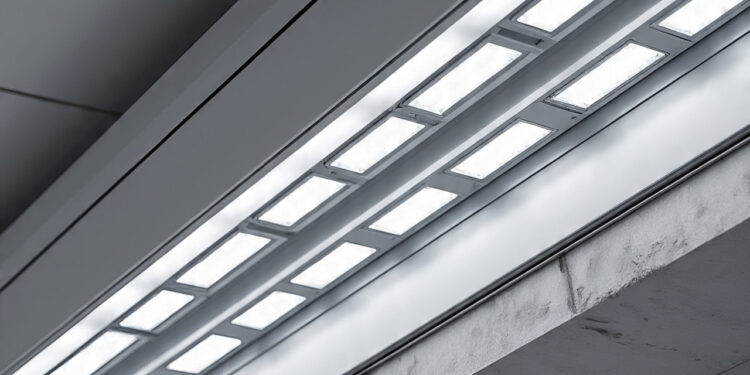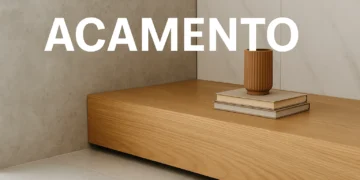Tunnels are important parts of our roads and cities. They help people travel safely under water, through mountains, or under busy streets. Good lighting in tunnels saves lives. It helps drivers see clearly and prevents crashes. LED tunnel lights are now the best choice for lighting these spaces.
Old tunnel lights used too much power and broke often. New LED tunnel lights work better. They use less energy and last much longer. This saves money and keeps tunnels safer for everyone who uses them.
What Are LED Tunnel Lights?
LED tunnel lights are special lights made just for tunnels. They give bright, clear light that helps people see well in dark spaces. These lights are stronger than regular lights. They can handle tough conditions like heat, cold, and dust.
Tunnel lighting faces unique problems. When people drive into a tunnel from bright sunlight, their eyes need time to adjust. This can be dangerous. Good LED tunnel lights fix this problem. They make the change from bright to dark much smoother and safer.
LED tunnel lights have many parts that work together:
• Strong housing: Protects the light from damage and weather • LED chips: Create the bright, white light • Heat sink: Keeps the LED cool so it lasts longer
• Driver: Controls how much power the LED uses • Lens: Spreads light evenly across the tunnel • Mounting system: Holds the light securely in place • Control wires: Connect to dimming and smart systems • Emergency backup: Keeps lights on during power problems • Sensors: Detect when to turn lights on or off • Weather seals: Keep water and dirt out of the light
Types of LED Tunnel Lights
Different tunnels need different types of lights. The size, shape, and use of a tunnel decides what lights work best. Each type has special features that make it good for certain jobs.
LED tunnel lights come in many shapes and sizes. Some are long strips. Others are round or square. The best choice depends on the tunnel design and what people do there.
Linear LED Tunnel Lights
Linear LED tunnel lights are long, thin lights that run along tunnel walls or ceilings. They create smooth, even light from one end of the tunnel to the other. Many tunnels use these lights because they work well and look clean.
These lights are easy to install and maintain. They can be joined together to make any length needed. This makes them perfect for long tunnels where you need lots of light.
Benefits of linear LED tunnel lights:
• Even light spread: No dark spots between lights • Custom lengths: Can be made to fit any tunnel size • Easy to install: Simple mounting system saves time • Lower cost: Fewer fixtures needed for long tunnels • Clean look: Smooth, professional appearance • Less maintenance: Fewer parts to check and replace • Good for highways: Perfect for high-speed traffic areas • Energy saving: Uses power efficiently across long distances • Flexible design: Can follow curved tunnel walls • Weather proof: Sealed against water and dust
Round LED Tunnel Lights
Round LED tunnel lights are circular fixtures that give focused light to specific areas. They work well in shorter tunnels or where you need extra bright light in certain spots. These lights are often used at tunnel entrances and exits.
Round lights are good for older tunnels where you need to replace existing round fixtures. They fit in the same holes as old lights, making upgrades easier and cheaper.
Uses for round LED tunnel lights:
• Tunnel entrances: Extra bright light where people enter • Exit areas: Good visibility when leaving the tunnel
• Emergency zones: Bright light near emergency phones and exits • Maintenance areas: Clear light for workers doing repairs • Sign lighting: Helps people read important signs • Pedestrian areas: Safe lighting for people walking • Loading zones: Bright light for trucks and delivery areas • Security spots: Good light for cameras and guards • Curved sections: Works well on bent tunnel walls • Retrofit projects: Easy replacement for old round lights
Recessed LED Tunnel Lights
Recessed LED tunnel lights are built into the tunnel wall or ceiling. Only the light part shows. The rest is hidden inside the tunnel structure. This protects the lights from damage and makes tunnels look better.
These lights are harder to install but last longer. They are perfect for busy tunnels where vandalism or accidents might damage regular lights. They also make cleaning the tunnel easier.
Advantages of recessed LED tunnel lights:
• Protected from damage: Hidden inside walls, safe from impacts • Clean appearance: Smooth tunnel walls with no protruding lights • Hard to vandalize: Difficult for people to break or damage • Easy tunnel cleaning: No fixtures block cleaning equipment • Long lasting: Protected environment helps lights last longer • Safe for tall vehicles: No risk of trucks hitting lights • Better air flow: Smooth walls don’t block ventilation • Professional look: Neat, high-end appearance • Reduced maintenance: Less cleaning and repair needed • Energy efficient: Good heat management keeps LEDs cool
Key Features of LED Tunnel Lights
Good LED tunnel lights have special features that make them work well in tough tunnel conditions. These features help the lights last longer, save energy, and keep people safe. Understanding these features helps you choose the right lights.
When buying LED tunnel lights, look for these important features. They make the difference between lights that work well and lights that cause problems later.
High Light Output
LED tunnel lights must give enough bright light for people to see clearly. This is measured in lumens. More lumens mean brighter light. Tunnels need lots of light because they are naturally dark spaces.
Good LED tunnel lights can produce 10,000 to 50,000 lumens or more. The exact amount depends on how long the tunnel is and how fast traffic moves through it. Highway tunnels need more light than walking tunnels.
Benefits of high light output:
• Better visibility: People can see obstacles, signs, and other cars clearly • Safer driving: Bright light prevents accidents and reduces crashes • Clear color vision: Shows true colors of warning signs and signals • Reduced eye strain: Eyes don’t have to work hard to see • Better security: Bright light deters crime and helps cameras work • Faster traffic flow: People drive more confidently in well-lit tunnels • Emergency response: Rescue workers can see clearly during emergencies • Maintenance work: Workers can do repairs safely with good light • All weather use: Light cuts through fog, rain, and snow • Day and night use: Consistent visibility regardless of outside conditions
Energy Efficiency
LED tunnel lights use much less power than old lighting types. This saves money on electric bills every month. Energy efficiency is measured in lumens per watt. Higher numbers mean more light for less power.
Good LED tunnel lights produce 120-160 lumens per watt. Old lights like sodium lamps only make 80-100 lumens per watt. This means LEDs give more light while using less electricity.
Energy efficiency benefits:
• Lower electric bills: Use 50-70% less power than old lights • Reduced carbon footprint: Less electricity means less pollution • Government rebates: Many places offer money back for LED upgrades • Grid stability: Less power demand helps prevent blackouts • Future proof: Ready for stricter energy rules coming soon • Cost predictable: Stable energy costs make budgeting easier • Peak demand savings: Lower power use during busy times saves money • Heat reduction: Less wasted energy as heat means cooler tunnels • System efficiency: Less load on electrical systems extends their life • Environmental benefits: Supports green building and sustainability goals
Long Lifespan
LED tunnel lights last much longer than traditional lights. While old lights might last 2-3 years, good LEDs can work for 15-20 years or more. This means fewer replacements and less maintenance work.
Long lifespan is especially important in tunnels. Changing lights in tunnels is expensive and dangerous. It often requires closing lanes or the whole tunnel. LEDs reduce these problems by lasting much longer.
Long lifespan advantages:
• Less maintenance: Fewer light changes needed over time • Lower labor costs: Less money spent on maintenance workers • Reduced traffic disruption: Fewer tunnel closures for light replacement • Better reliability: Lights don’t fail when you need them most • Lower total cost: Initial cost spread over many more years • Less waste: Fewer old lights going to landfills • Consistent performance: Light output stays stable for years • Safety improvement: Reliable lights mean safer tunnel conditions • Budget planning: Predictable replacement schedules • Warranty coverage: Long warranties protect your investment
Weather Protection
Tunnel environments are tough on lights. There is moisture, dust, temperature changes, and vibration from traffic. LED tunnel lights need strong protection to work well in these conditions.
Good LED tunnel lights have high IP ratings. IP65 or IP67 ratings mean the lights are sealed against water and dust. This protection keeps the lights working even in wet or dirty conditions.
Weather protection features:
• Water resistance: Sealed against rain, moisture, and condensation • Dust protection: Keeps dirt and particles out of light housing • Temperature stability: Works in hot and cold conditions • Vibration resistance: Handles shaking from passing vehicles • Corrosion protection: Special coatings prevent rust and damage • UV resistance: Won’t fade or crack from sunlight exposure • Impact resistance: Strong housing protects from accidents • Chemical resistance: Withstands car exhaust and road chemicals • Thermal management: Good heat control prevents overheating • Gasket sealing: Multiple seals keep environmental threats out
Applications of LED Tunnel Lights
LED tunnel lights are used in many different types of tunnels. Each type has special needs that LED lights can meet. Understanding these applications helps choose the right lighting solution for each situation.
Different tunnels serve different purposes. Highway tunnels move cars quickly. Pedestrian tunnels keep people safe. Each needs lighting designed for its specific use.
Highway Tunnels
Highway tunnels carry fast-moving traffic. Cars and trucks travel at high speeds through these tunnels. The lighting must help drivers see clearly and react quickly to any problems ahead.
Highway tunnel lighting is complex. It must handle the transition from bright sunlight to tunnel darkness. This requires special zones with different light levels to help eyes adjust gradually.
Highway tunnel lighting needs:
• High light levels: Bright enough for high-speed driving safety • Smooth transitions: Gradual light changes at tunnel entrances and exits • Uniform coverage: Even light across all driving lanes • Glare control: Prevents blinding from headlights and reflections • Emergency lighting: Backup power for safety during outages • Traffic sensing: Lights adjust based on traffic volume • Weather adaptation: Brighter light during fog or rain • Sign illumination: Good visibility of warning and guide signs • Maintenance lighting: Extra light for road work and repairs • Smart controls: Central monitoring and automatic adjustments
Pedestrian Tunnels
Pedestrian tunnels help people walk safely under roads, railways, or waterways. These tunnels need lighting that makes people feel safe and comfortable. Good lighting prevents crime and helps people find their way.
Pedestrian tunnels often have problems with vandalism. The lights must be strong enough to resist damage. They also need to create a welcoming environment that people want to use.
Pedestrian tunnel requirements:
• Security lighting: Bright enough to deter crime and help surveillance • Comfortable light: Warm, friendly light that reduces fear • Vandal resistance: Strong fixtures that can’t be easily damaged • Emergency features: Clear marking of exits and emergency phones • Motion sensors: Lights brighten when people approach • Energy saving: Dimmed when empty to save power • Easy maintenance: Simple access for cleaning and repairs • Wayfinding support: Good visibility of directional signs • Accessibility features: Lighting that helps people with disabilities • Weather protection: Sealed lights for wet conditions
Subway Tunnels
Subway and train tunnels have special lighting needs. They must light both the tracks for trains and platforms for passengers. The lighting system must work reliably because transportation depends on it.
Subway tunnels face challenges from train vibration, electrical interference, and the need for emergency evacuation lighting. LED lights handle these challenges better than old lighting types.
Subway tunnel considerations:
• Platform lighting: Safe boarding and walking areas for passengers • Track illumination: Clear visibility for train operators • Emergency evacuation: Bright light to guide people to safety • Vibration resistance: Lights that handle train movement and switching • Electrical compatibility: Works with train power systems without interference • Maintenance access: Easy to service without disrupting train schedules • Backup power: Battery systems for power failures • Fire safety: Lights that work during smoke and heat emergencies • Communication support: Good lighting for passenger information systems • Aesthetic appeal: Pleasant environment for daily commuters
Industrial Tunnels
Industrial tunnels are used for utilities, mining, or manufacturing. These tunnels need specialized lighting for different types of work. The lights must be extra strong and reliable because industrial work depends on them.
Industrial environments can be harsh. There may be chemicals, extreme temperatures, or dangerous gases. LED tunnel lights for industrial use need special certifications and protective features.
Industrial tunnel specifications:
• Hazardous location ratings: Safe for use near flammable materials • Chemical resistance: Protected against industrial chemicals and vapors • High temperature operation: Works in hot industrial environments • Explosion proof options: Special housing for dangerous areas • Heavy duty construction: Extra strong to handle industrial abuse • Task lighting: Focused light for detailed work and inspections • Color accuracy: True color rendering for quality control work • Maintenance durability: Long life in tough industrial conditions • Emergency compliance: Meets industrial safety regulations • Integration capability: Works with industrial control systems
Installation of LED Tunnel Lights
Installing LED tunnel lights requires careful planning and skilled workers. Tunnel installation is more complex than regular lighting because of safety concerns and difficult working conditions. Good installation ensures the lights work properly and last a long time.
Professional installation is usually required for tunnel lighting. The work involves electrical systems, traffic management, and safety procedures that need experienced teams to handle properly.
Planning Phase
Good planning makes LED tunnel light installation successful. This phase involves studying the tunnel, designing the lighting system, and preparing for the work. Planning takes time but prevents problems later.
The planning team includes lighting designers, electrical engineers, and safety experts. They work together to create a lighting plan that meets all requirements and can be installed safely.
Planning considerations:
• Tunnel survey: Measure dimensions, check electrical systems, identify obstacles • Light calculations: Determine how many lights and where to place them • Electrical design: Plan power supplies, controls, and emergency systems • Traffic management: Organize work schedules to minimize traffic disruption • Safety planning: Develop procedures to protect workers and tunnel users • Permit applications: Get required approvals from transportation authorities • Material ordering: Purchase lights, mounting hardware, and electrical supplies • Schedule coordination: Arrange work times with tunnel operators • Quality procedures: Plan inspection and testing processes • Documentation preparation: Create installation drawings and specifications
Mounting Methods
LED tunnel lights can be mounted in several ways. The best method depends on the tunnel construction and the type of lights being installed. Strong, secure mounting is essential for safety and long-term reliability.
Most tunnel lights are mounted on walls or ceilings using metal brackets. The mounting system must handle vibration from traffic and support the weight of the lights. Proper mounting also helps with heat management and maintenance access.
Common mounting options:
• Wall mounting: Lights attached to tunnel walls using metal brackets • Ceiling mounting: Fixtures hung from tunnel ceiling structure • Recessed installation: Lights built into wall or ceiling openings • Cable suspension: Lights hung on cables across tunnel width • Track mounting: Multiple lights on moveable track systems • Pole mounting: Lights on posts in wider tunnel areas • Clamp mounting: Quick installation on existing structures • Magnetic mounting: Temporary installation for special situations • Adjustable brackets: Allows aiming lights in different directions • Vibration isolators: Special mounts that reduce vibration damage
Electrical Connections
Electrical work in tunnels requires special skills and safety procedures. The power systems must be reliable and safe for both workers and tunnel users. Proper electrical connections prevent problems and ensure long light life.
Tunnel electrical systems often use higher voltages than regular buildings. There may also be special requirements for emergency power and control systems. All electrical work must meet safety codes and tunnel regulations.
Electrical installation steps:
• Power supply verification: Check that electrical capacity meets light requirements • Circuit protection: Install proper breakers and safety devices • Cable installation: Run electrical cables in approved conduit systems • Grounding systems: Connect all equipment to proper ground systems • Control wiring: Install dimming and sensor control connections • Emergency circuits: Connect backup power and emergency lighting systems • Testing procedures: Verify all electrical connections work correctly • Safety compliance: Meet all electrical codes and tunnel safety rules • Documentation: Record all electrical connections and circuit information • Commissioning: Test complete system operation before opening tunnel
Maintenance of LED Tunnel Lights
LED tunnel lights need less maintenance than old lights, but they still need some care to work their best. Good maintenance keeps the lights bright, prevents failures, and extends their life. Regular maintenance also saves money by preventing bigger problems.
Tunnel maintenance is challenging because of traffic, safety concerns, and difficult access. A good maintenance plan addresses these challenges while keeping the lighting system reliable.
Regular Cleaning
Tunnel lights get dirty from car exhaust, road dust, and moisture. Dirty lights give less light and work harder, which shortens their life. Regular cleaning keeps lights bright and efficient.
Cleaning frequency depends on tunnel conditions. Busy highways with diesel trucks need more frequent cleaning than pedestrian tunnels. Most tunnels benefit from cleaning every 6-12 months.
Cleaning procedures:
• Safety preparations: Close traffic lanes or work during low-traffic periods • Worker protection: Use proper safety equipment and procedures • Gentle cleaning: Use mild soap and soft cloths to avoid damage • Dry thoroughly: Remove all moisture to prevent corrosion • Inspect while cleaning: Look for damage or wear during cleaning • Replace gaskets: Change seals if they show wear or damage • Document conditions: Record any problems found during cleaning • Test after cleaning: Verify lights work properly after maintenance • Update records: Keep maintenance logs for warranty and planning • Schedule next cleaning: Plan the next maintenancebased on conditions
Performance Monitoring
Modern LED tunnel lights can be monitored remotely to track their performance. This helps identify problems before lights fail completely. Monitoring systems save money by preventing emergency repairs and traffic disruptions.
Good monitoring tracks light output, energy use, and system faults. This information helps plan maintenance and upgrades. It also provides data to improve future lighting installations.
Monitoring benefits:
• Early problem detection: Find issues before complete light failure • Energy tracking: Monitor power use and identify efficiency problems • Performance trends: See how lights perform over time • Maintenance planning: Schedule work based on actual needs • Cost control: Reduce emergency repairs and traffic disruptions • Warranty support: Provide data for warranty claims • System optimization: Adjust settings for better performance • Failure analysis: Understand why problems occur • Inventory management: Know when replacement parts are needed • Reporting: Provide performance data to tunnel operators
Replacement Planning
Even long-lasting LED lights eventually need replacement. Good planning ensures replacements happen before lights fail and cause safety problems. Planning also helps control costs by allowing bulk purchases and scheduled work.
Replacement planning uses performance data, maintenance records, and manufacturer recommendations. The goal is to replace lights at the optimal time – not too early (wasting money) and not too late (risking failures).
Replacement strategies:
• Life cycle tracking: Monitor how long each light has operated • Performance degradation: Replace lights when output drops too low • Group replacement: Change multiple lights at once to save labor costs • Preventive replacement: Change lights before they fail completely • Emergency inventory: Keep spare lights for unexpected failures • Technology upgrades: Consider newer, better lights when replacing • Seasonal planning: Schedule replacement during favorable weather • Budget planning: Spread replacement costs over multiple years • Vendor relationships: Work with suppliers for better prices and service • Installation efficiency: Use experienced crews for faster, safer replacement







